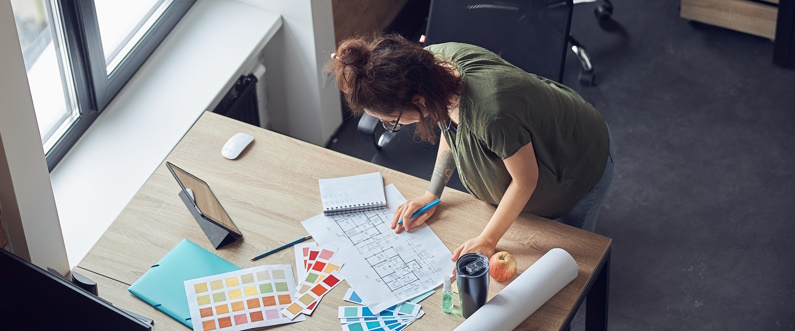Work with Our Home Remodeling Company in Kansas City for Help Creating a Balanced and Unified Space
Remodeling a bathroom or kitchen leaves you with a blank canvas to reimagine your space however you see fit. The possibilities are endless, often making it a daunting task to choose elements that work together while also matching your style.
Creating a cohesive bathroom or kitchen remodel is all about balance. But of course, that’s easier said than done. It’s why so many people hire a designer to help.
To give you a better grasp on incorporating colors, tiles, and finishes in a room, we looked to our in-house experts for advice.
The Basics of Color Theory
To understand how you can develop a harmonized space through a bathroom or kitchen remodel, you first need to know color theory.
Think about the color wheel for a second. Yes, the circular rainbow illustration you learned about in art class. It can be broken down into three levels:
- The primary colors are red, yellow, and blue and form the foundation of the color wheel.
- When the primary colors are equally mixed, you get the secondary colors – orange, green, and purple.
- Tertiary colors are the final layer and made by mixing primary and secondary colors together, resulting in hues like blue-green and red-orange.
From these colors, you can make color schemes like the following:
- Monochromatic: A scheme of the same color in different tones, such as various shades or tints of blue.
- Analogous: A scheme of colors located right next to each other on the color wheel, like yellow, yellow-orange, and orange.
- Complementary: A scheme of colors directly opposite each other on the color wheel, like blue and orange.
- Split Complementary: A complementary color scheme where one color is split into two adjacent colors on the color wheel. Think blue and orange still, but you’d specifically have blue, red-orange, and yellow-orange.
- Triadic: A scheme of three colors equidistant from each other on the color wheel, like red-purple, blue-green, and yellow-orange.
- Tetradic: A scheme of four colors equidistant from each other on the color wheel or two pairs of complementary colors, like yellow, purple, blue-green, and red-orange.
How to Use Color in a Bathroom or Kitchen Remodel
Now that you’re familiar with color theory, we can get back to how this can be applied to your bathroom or kitchen remodel.
When you’ve got a scheme that suits your style, you can begin planning how you’ll use it in your design. A good rule of thumb is 70/20/10 for bathrooms or kitchens with three main colors (or 70/30 for those with only two). What we mean by that is choosing a feature color to distribute throughout 70 percent of the room while the other accent colors get 20 and 10 percent, respectively.
Another color aspect to consider is creating contrast. Typically, lighter colors help an area feel bigger and brighter, adding more dimension and height when used in upper parts of a room. Opt for these in countertops, backsplashes, and shower tiles. Dark colors ground a space and give a warm and cozy feel. Apply these colors when selecting flooring, a kitchen island, or even lower cabinets.
Keep in mind that not every surface needs to be different, however. If you choose light gray quartz countertops, think about how you can incorporate that same hue somewhere else – such as the wall paint color.
All these efforts guarantee a proportionate, aesthetically pleasing space, with no colors competing against each other.
Selecting Complementary Tiles for Bathroom or Kitchen Remodel
There’s a lot to consider when deciding on bathroom and kitchen tiles, starting with what material you want to use. Porcelain, limestone, and slate are ideal for achieving a more rustic look, while a material like marble instantly elevates your space and evokes luxury.
And just as there are several materials to choose from, there are just as many styles. Some of these include:
- Subway Tiles: These classic tiles get their name for being reminiscent of subway stations and look beautiful almost anywhere. Timeless, versatile, and easy to clean, they’re one of the most popular choices among homeowners.
- Diamond-Shaped Tiles: Diamond-shaped tiles add geometric intrigue to a kitchen backsplash, shower wall, or bathroom floor. Most often used in more contemporary designs, this shape can also give some modern flair to traditional spaces.
- Fish Scale Tiles: Reminiscent of fish scales, these tiles, sometimes called fan or scallop tiles, are a fun and eye-catching inclusion in a bathroom or kitchen remodel. Their whimsical shape is perfect for creating striking detail on a feature wall or shower niche.
- Arabesque Tiles: For a more traditional and elegant design, look no further than these lantern-shaped tiles. Options with a beveled edge can even kick the dimension and texture of a design up a notch.
- Mosaic Tiles: Mosaic tiles allow you to do something completely unique. You have the freedom to play with shapes, sizes, and various colors here, essentially creating your very own piece of in-home art.
Of course, you still need to take into account your color scheme. If you have bolder kitchen cabinets, you may want to use a simple, unassuming tile style like subway tiles for the backsplash to avoid too much complexity. On the other hand, if you have a more muted space, you can make a statement with an eclectic mosaic feature.
Whatever your vision, our bathroom and kitchen remodeling contractors will work with you on every detail – including tile – to ensure the final product is everything you dreamed it would be.
Choosing the Right Finishes for a Bathroom or Kitchen Remodel
Finishes encompass all the “finishing touches” that make up a bathroom or kitchen remodel – metal hardware, flooring, countertops, and more. Making sure these all enhance the color scheme, rather than detract from it, is the key.
Let’s start with your metal elements. Brass, bronze, and gold build on the warmth of colors like blush, cream, and taupe. In contrast, cool metal finishes like chrome, nickel, and silver pair well with green and blue hues.
In cases of a neutral palette, metals can be used to add color and texture. A black and white bathroom, for instance, can benefit from gold faucets and cabinet pulls, helping add another layer of interest to the space.
When it comes to flooring and countertops, look for ways to bring in colors and tones used elsewhere. Maybe you’re able to nod to your blue kitchen cabinets with granite countertops that feature speckles of the same hue. Or maybe you complement them with a cool-toned, ash wood floor.
Remember, it’s not about matching, but coordinating. Like when you get dressed for the day, your shoes don’t match your outfit exactly, but they still go together. It’s the same idea in a bathroom or kitchen remodel. Your colors, tiles, and finishes work in tandem to result in a holistically brilliant space.
Bring Your Coordinated Space Dreams to Life with Help from Our Bathroom and Kitchen Remodeling Contractors
NextGen is a home remodeling company in Kansas City specializing in kitchens and bathrooms and serving nearby cities including but not limited to Overland Park, Prairie Village, Leawood, Olathe, and Lee’s Summit.
Whether you’re looking for a small bathroom remodel near you or a larger-scale project, we have the tools, experience, and commitment to create all that you’ve been dreaming of and more.
We pride ourselves on taking the stress out of renovations and ensuring your needs are met from start to finish. You can expect an easy-to-understand process and open communication channels when you partner with us for a professional home remodel.
To see some of our most recent work and get the inspiration flowing, check out our portfolio.
Already know what you’re looking for? Contact us for an estimate by submitting our online form. We can’t wait to learn all about your project!

